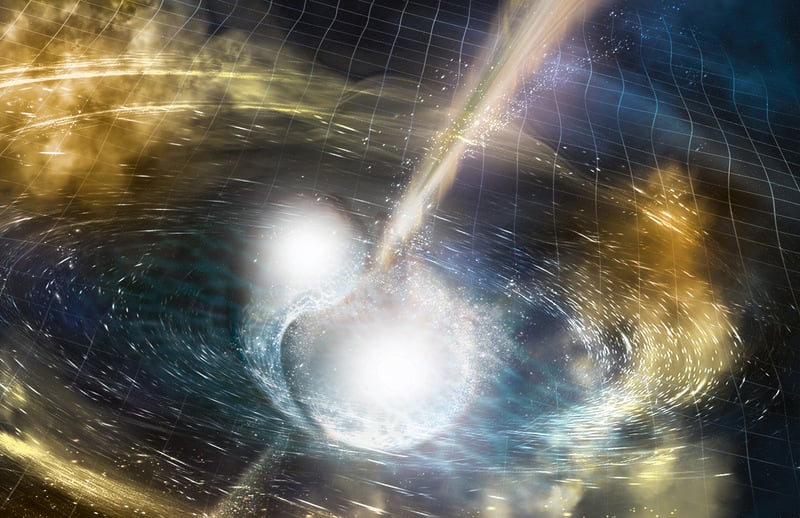In
August of 2017
, a major breakthrough occurred when scientists at the
Laser Interferometer Gravitational-Wave Observatory
(LIGO) detected gravitational waves that were believed to be caused by the collision of two neutron stars. This source, known as GW170817/GRB, was the first gravitational wave (GW) event that was not caused by the merger of two black holes, and was even believed to have led to the
formation of one
.
As such, scientists from all over the world have been studying this event ever since to learn what they can from it. For example, according to a
new study
led by the
McGill Space Institute and Department of Physics
, GW170817/GRB has shown some rather strange behavior since the two neutron stars colliding last August. Instead of dimming, as was expected, it has been gradually growing brighter.
The study that describes the team's findings, titled "
Brightening X-Ray Emission from GW170817/GRB 170817A: Further Evidence for an Outflow
", recently appeared in
The Astrophysical Journal Letters.
The study was led by John Ruan of McGill University's Space Institute and included members from the
Canadian Institute for Advanced Research
(CIFAR), Northwestern University, and the
Leicester Institute for Space and Earth Observation
.
[caption id="attachment_138306" align="aligncenter" width="580"]
Chandra images showing the X-ray afterglow of the GW170817/GRB event. Credit: NASA/CXC/McGill University/J. Ruan et al.
[/caption]
For the sake of their study, the team relied on data obtained by NASA's
Chandra X-ray Observatory
, which showed that the remnant has been brightening in the X-ray and radio wavelengths in the months since the collision took place. As Daryl Haggard, an astrophysicist with McGill University whose research group led the new study, said in a recent Chandra
press release
:
What's more, these X-ray observations are consistent with radiowave data reported last month by another team of scientists, who also indicated that it was continuing to brighten during the three months since the collision. During this same period, X-ray and optical observatories were unable to monitor GW170817/GRB because it was too close to the Sun at the time.
However, once this period ended, Chandra was able to gather data again, which was consistent with these other observations. As John Ruan
explained
:
[caption id="attachment_103553" align="aligncenter" width="580"]
Collisions of neutron stars produce powerful gamma-ray bursts – and heavy elements like gold (Credit: Dana Berry, SkyWorks Digital, Inc.)
[/caption]
This unexpected behavior has led to a serious buzz in the scientific community, with astronomers trying to come up with explanations as to what type of physics could be driving these emissions. One theory is a complex model for neutron star mergers known as "cocoon theory". In accordance with this theory, the merger of two neutron stars could trigger the release of a jet that shock-heats the surrounding gaseous debris.
This hot "cocoon" around the jet would glow brightly, which would explain the increase in X-ray and radiowave emissions. In the coming months, additional observations are sure to be made for the sake of confirming or denying this explanation. Regardless of whether or not the "cocoon theory" holds up, any and all future studies are sure to reveal a great deal more about this mysterious remnant and its strange behavior.
As Melania Nynka, another McGill postdoctoral researcher and a co-author on the paper indicated, GW170817/GRB presents some truly unique opportunities for astrophysical research. "This neutron-star merger is unlike anything we've seen before," she said. "For astrophysicists, it's a gift that seems to keep on giving."
It is no exaggeration to say that the first-ever detection of gravitational waves, which took place in
February of 2016
, has led to a new era in astronomy. But the detection of two neutron stars colliding was also a revolutionary accomplishment. For the first time, astronomers were able to observe such an event in both light waves and gravitational waves.
In the end, the combination of improved technology, improved methodology, and closer cooperation between institutions and observatories is allowing scientists to study cosmic phenomena that was once merely theoretical. Looking ahead, the possibilities seem almost limitless!
Further Reading: Chandra X-Ray Observatory
,
*The Astrophysical Journal Letters*
 Universe Today
Universe Today
